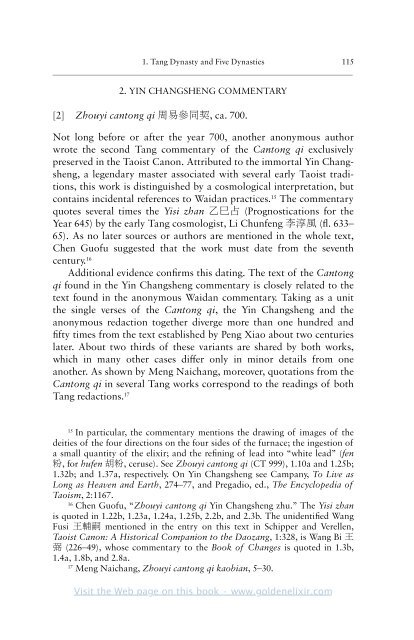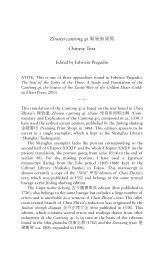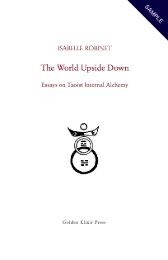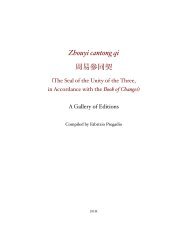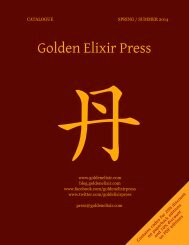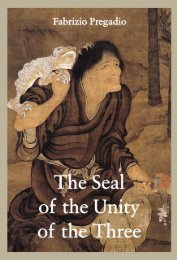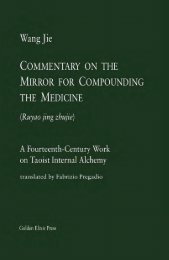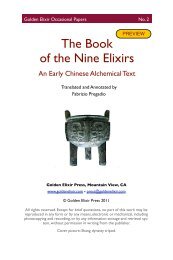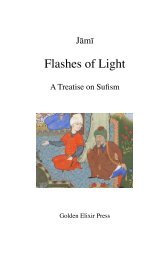The Seal of the Unity of the Three â Vol. 2 - The Golden Elixir
The Seal of the Unity of the Three â Vol. 2 - The Golden Elixir
The Seal of the Unity of the Three â Vol. 2 - The Golden Elixir
- No tags were found...
You also want an ePaper? Increase the reach of your titles
YUMPU automatically turns print PDFs into web optimized ePapers that Google loves.
1. Tang Dynasty and Five Dynasties 115<br />
—————————————————————————————————————————<br />
2. YIN CHANGSHENG COMMENTARY<br />
[2] Zhouyi cantong qi 周 易 參 同 契 , ca. 700.<br />
Not long before or after <strong>the</strong> year 700, ano<strong>the</strong>r anonymous author<br />
wrote <strong>the</strong> second Tang commentary <strong>of</strong> <strong>the</strong> Cantong qi exclusively<br />
preserved in <strong>the</strong> Taoist Canon. Attributed to <strong>the</strong> immortal Yin Changsheng,<br />
a legendary master associated with several early Taoist traditions,<br />
this work is distinguished by a cosmological interpretation, but<br />
contains incidental references to Waidan practices. 15 <strong>The</strong> commentary<br />
quotes several times <strong>the</strong> Yisi zhan 乙 巳 占 (Prognostications for <strong>the</strong><br />
Year 645) by <strong>the</strong> early Tang cosmologist, Li Chunfeng 李 淳 風 (fl. 633–<br />
65). As no later sources or authors are mentioned in <strong>the</strong> whole text,<br />
Chen Gu<strong>of</strong>u suggested that <strong>the</strong> work must date from <strong>the</strong> seventh<br />
century. 16<br />
Additional evidence confirms this dating. <strong>The</strong> text <strong>of</strong> <strong>the</strong> Cantong<br />
qi found in <strong>the</strong> Yin Changsheng commentary is closely related to <strong>the</strong><br />
text found in <strong>the</strong> anonymous Waidan commentary. Taking as a unit<br />
<strong>the</strong> single verses <strong>of</strong> <strong>the</strong> Cantong qi, <strong>the</strong> Yin Changsheng and <strong>the</strong><br />
anonymous redaction toge<strong>the</strong>r diverge more than one hundred and<br />
fifty times from <strong>the</strong> text established by Peng Xiao about two centuries<br />
later. About two thirds <strong>of</strong> <strong>the</strong>se variants are shared by both works,<br />
which in many o<strong>the</strong>r cases differ only in minor details from one<br />
ano<strong>the</strong>r. As shown by Meng Naichang, moreover, quotations from <strong>the</strong><br />
Cantong qi in several Tang works correspond to <strong>the</strong> readings <strong>of</strong> both<br />
Tang redactions. 17<br />
15<br />
In particular, <strong>the</strong> commentary mentions <strong>the</strong> drawing <strong>of</strong> images <strong>of</strong> <strong>the</strong><br />
deities <strong>of</strong> <strong>the</strong> four directions on <strong>the</strong> four sides <strong>of</strong> <strong>the</strong> furnace; <strong>the</strong> ingestion <strong>of</strong><br />
a small quantity <strong>of</strong> <strong>the</strong> elixir; and <strong>the</strong> refining <strong>of</strong> lead into “white lead” (fen<br />
粉 , for hufen 胡 粉 , ceruse). See Zhouyi cantong qi (CT 999), 1.10a and 1.25b;<br />
1.32b; and 1.37a, respectively. On Yin Changsheng see Campany, To Live as<br />
Long as Heaven and Earth, 274–77, and Pregadio, ed., <strong>The</strong> Encyclopedia <strong>of</strong><br />
Taoism, 2:1167.<br />
16<br />
Chen Gu<strong>of</strong>u, “Zhouyi cantong qi Yin Changsheng zhu.” <strong>The</strong> Yisi zhan<br />
is quoted in 1.22b, 1.23a, 1.24a, 1.25b, 2.2b, and 2.3b. <strong>The</strong> unidentified Wang<br />
Fusi 王 輔 嗣 mentioned in <strong>the</strong> entry on this text in Schipper and Verellen,<br />
Taoist Canon: A Historical Companion to <strong>the</strong> Daozang, 1:328, is Wang Bi 王<br />
弼 (226–49), whose commentary to <strong>the</strong> Book <strong>of</strong> Changes is quoted in 1.3b,<br />
1.4a, 1.8b, and 2.8a.<br />
17<br />
Meng Naichang, Zhouyi cantong qi kaobian, 5–30.<br />
Visit <strong>the</strong> Web page on this book • www.goldenelixir.com


